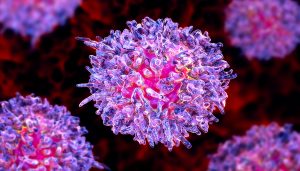 Approved by the FDA in 1993, the drug cladribine offered hope for the then-fatal blood cancer called hairy cell leukemia, or HCL, and was soon expanded as a therapy for multiple sclerosis. Developed by NFCR scientist Dr. Dennis Carson at the University of California, San Diego, cladribine acts like a purine nucleoside agent, which prevents cells from making DNA and RNA, and can selectively kill hairy cell leukemia cells. Heralded as a breakthrough cure, cladribine remains the first-line treatment for HCL and is also tapped as a treatment for B-cell chronic lymphocytic leukemia. Now researchers have expanded its use to another deadly form of leukemia, drug-resistant T-cell prolymphocytic leukemia (T-PLL).
Approved by the FDA in 1993, the drug cladribine offered hope for the then-fatal blood cancer called hairy cell leukemia, or HCL, and was soon expanded as a therapy for multiple sclerosis. Developed by NFCR scientist Dr. Dennis Carson at the University of California, San Diego, cladribine acts like a purine nucleoside agent, which prevents cells from making DNA and RNA, and can selectively kill hairy cell leukemia cells. Heralded as a breakthrough cure, cladribine remains the first-line treatment for HCL and is also tapped as a treatment for B-cell chronic lymphocytic leukemia. Now researchers have expanded its use to another deadly form of leukemia, drug-resistant T-cell prolymphocytic leukemia (T-PLL).
In a small study, T-PLL patients were desensitized to the antibody drug, alemtuzumab when it was combined with cladribine; the cancer essentially lost its drug resistance. In seven out of eight patients, the cladribine-alemtuzumab combo resulted in complete remissions, and a partial remission in the final patient. As of 2015, some patients remain in remission, although others have passes away. Alemtuzumab is marketed under the name Campath; cladribine under the name Leustatin.
Considered very rare, T-PLL is an aggressive cancer of the out of control growth of mature T-cells, the assassins of the immune system. Chromosomal abnormalities are a hallmark in T-PLL patients; the most common chromosomal abnormalities are inversions or translocations involving chromosome 14 that result in mutations to the proto-oncogene TCL-1 (oncogenes are genes which in certain circumstances can transform a healthy cell to a cancerous one). Also frequently detected in patients with T-PLL are abnormalities in chromosome 8, primarily trisomy 8q, which is an extra copy of genetic material on the long arm (q) of chromosome 8. Deletions or mutations to the tumor suppressor gene ATM have also been observed in patients with T-PLL. Symptoms include bruising easily, rashes or skin lesions, swollen lymph nodes, quickly feeling full when eating, abdominal pain on the left side of the body due to a swollen spleen, and fullness.
Cladribine was a trailblazer at the time of its introduction over 20 years ago.
“[It was] a targeted agent directed against lymphocytes at a time when there was no such thing as targeted agents,” Carson recalls; targeted drugs and therapies are now among the hottest fields in medicine.
Other treatments for T-PLL include combining alemtuzumab with the drug pentostatin, the FMC drug combination (fludarabine, mitoxantrone, and cyclophosphamide) followed by intravenous alemtuzumab, and hematopoietic stem cell transplantation. While it is not FDA-approved as a treatment for T-PLL, the drug nelarabine can also be used in some cases.
Researchers admit that the initial trial of the cladribine-alemtuzumab combination dealt with a very small number of patients and that larger studies will have to be done per standard medical protocol to confirm safety and efficacy. That being said, the drug combination may move more quickly out of the trial phase and into practice due to the fact that both drugs are already approved by the FDA.
Categories: NEWS

